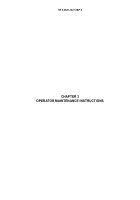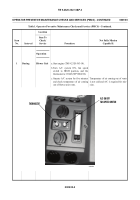TB-9-2320-302-13-P-3 - Page 40 of 240
TB 9-2320-302-13&P-3
OPERATOR PREVENTIVE MAINTENANCE CHECKS AND SERVICES (PMCS)
INTRODUCTION - CONTINUED
0008 00
0008 00-2
GENERAL PMCS PROCEDURES - CONTINUED
WARNING
•
Solvent cleaning compound MIL-PRF-680 Type II and III may be irritating to the eyes and skin. Use
protective gloves and goggles. Use in well-ventilated areas. Use respirator as needed. Accidental inges-
tion can cause irritation of digestive tract and respiratory tract, may cause lung and central nervous sys-
tem damage. Can be fatal if swallowed. Inhalation of high/massive concentrations can cause coma or be
fatal. First aid for ingestion: do not induce vomiting. Seek immediate medical attention. First aid for
skin contact: remove contaminated clothing. Wash skin thoroughly with soap and water. If symptoms
persist, seek medical attention. First aid for eye contact: flush with water for 15 minutes or until irrita-
tion subsides. If symptoms persist, seek medical attention. First aid for inhalation: move to fresh air. If
not breathing, provide artificial respiration. If symptoms persist, seek medical attention. Keep away
from open flames and other sources of ignition.
•
The flashpoint for type II solvent cleaning compound is 141-198°F (61-92°C) and type III is 200-241°F
(93-116°C).
•
Improper cleaning methods and use of unauthrized cleaning solvents may injure personnel and damage
equipment.
•
Fire extinguishers should be placed nearby when using solvent cleaning compound.
•
Cloths or rags saturated with solvent cleaning compound must be disposed of IAW authorized facilities’
procedures.
•
Eye shields must be worn when cleaning with a wire brush. Flying rust and metal particle may cause
injury.
•
Failure to follow these warnings may result in injury or death to personnel.
a.
Keep It Clean.
Dirt, grease, oil, and debris get in the way and may cover up a serious problem. Clean as you work
and as needed. Use Cleaning Compound, Solvent, Type III (Item 2, WP 0025 00) on all metal surfaces. Use Deter-
gent, General Purpose, Liquid (Item 5, WP 0025 00) and water when you clean rubber, plastic, and painted sur-
faces.
WARNING
•
Contact with refrigerant can cause frostbite. Keep hands and face away to prevent personal injury.
•
Protective face shield must always be worn when refrigerant lines are opened, even if the gauges indi-
cate the system is empty.
•
Always use caution if a fitting is removed. Slowly loosen the fitting. If the system is still under any
pressure, release it slowly in a well-ventilated area.
•
DO NOT smoke when servicing A/C or wherever refrigerant gas may be present.
•
Failure to follow these warnings may result in injury or death to personnel.
b.
A/C Hoses and Fittings.
Inspect A/C hoses and fittings for any signs of leakage. Leaks can be identified by oily
residue on or near fittings and hoses.
c.
A/C Evaporator and Condenser.
Inspect condenser and evaporator cores for damaged vanes or any signs of leak-
age. Leaks can be identified by oily residue on the evaporator core or condenser core.
Back to Top




















